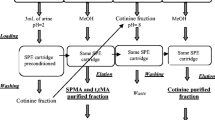Summary
trans,trans-Muconic acid (2,4-hexadienedioic acid) (t,t-MA) is a minor benzene metabolite which can be used as a biological indicator for benzene exposure. The purpose of the study was to evaluate the limits of use of t,t-MA for detection and quantification of occupational exposures to benzene, particularly on an individual scale, phenol being used as the metabolite of reference. A simple and sensitve method previously described by the authors was carried out to analyse t,t-MA in 105 end-of-shift urinary samples from 23 workers exposed to benzene used as an extraction solvent for “concretes” recovery in the perfume industry. Good correlations were found between atmospheric benzene and both metabolites (uncorrected or corrected for creatinine) or between the metabolites themselves, with correlation coefficients from 0.81 to 0.91 (P < 0.0001). Correlation-coefficients were not improved after correction for creatinine. The overall individual benzene exposure range, median, and arithmetic mean were respectively 0.1–75, 4.5, and 9.0 ppm with corresponding t,t-MA excretion of 0.1–47.9, 5.2 and 8.9 mg/l (uncorrected) and phenol excretion of 1.4–298, 30.9, and 42.2 mg/l (uncorrected). In the control group (145 determinations for t,t-MA and 76 for phenol from 79 individuals) the range, median, and arithmetic mean were respectively < 0.04–0.66, 0.08, and 0.13 mg/l (uncorrected t,t-MA) and 1.5–42.0, 9.85 and 11.3 mg/l (uncorrected phenol). t,t-MA was far more specific than phenol and could be easily and practically used to estimate with a given probability the upper or lower corresponding benzene concentrations down to around the ppm level. Biological exposure indices for benzene exposure to 10, 5, or 1 ppm could be set at 10, 5, or 1 mg t,t-MA/l (uncorrected).
Similar content being viewed by others
References
AFNOR (1986) Norme française NFX43-251 Qualité de l'air. Atmosphères des lieux de travail. Détermination de la concentration des hydrocarbures aromatiques monoclycliques en phase vapeur. Paris
Bechtold WE, Lucier G, Birnbaum LS, Yin SN, Li GL, Henderson RF (1991) Muconic acid determinations in urine as a biological exposure index for workers occupationally exposed to benzene. Am Ind Hyg Assoc J 52:473–479
Bowman JD, Held JL, Factor DR (1990) A field evaluation of mandelic acid in urine as a compliance monitor for styrene exposure. Appl Occup Environ Hyg 5:526–535
Campbell L, Marsh DM, Wilson HK (1987) Towards a biological monitoring strategy for toluene. Ann Occup Hyg 31:121–123
Colombi A, Buratti M, Zochetti C, Imbriani M, Ghittori S (1989) Limiti biologici di esposizione: evoluzione dei criteri interpretativi e metodologici. Med Lav 80:25–42
Ducos P, Gaudin R, Robert A, Francin JM, Maire C (1990) Improvement in HPLC analysis of urinary trans,trans-muconic acid, a promising substitute for phenol in the assessment of benzene exposure. Int Arch Occup Environ Health 62:529–534
Elia VJ, Anderson LA, MacDonald TJ, Carson A, Buncher CR, Brooks SM (1980) Determination of urinary mandelic and phenylglyoxylic acids in styrene exposed workers and a control population. Am Ind Hyg Assoc J 41:922–926
Engström K, Härkönen H, Pekari K, Rantanen J (1978) Evaluation of occupational styrene exposure by ambient air and urine analysis. Scand J Work Environ Health 4:121–123
Gad-El Karim MM, Sandagopa Ramanujam VM, Legator MS (1985) trans,trans-Muconic acid, an open chain urinary metabolite of benzene in mice. Quantification by high-pressure liquid chromatography. Xenobiotica 15:211–220
Heath DF (1967) Normal or log-normal: appropriate distributions. Nature 213:1159–1160
Hornung RW, Reed LD (1990) Estimation of average concentration in the presence of non detectable values. Appl Occup Environ Hyg 5:46–51
Inoue O, Seiji K, Nakatsuka H, Watanabe T, Yin S-N, Li G-L, Cai S-X, Jin C, Ikeda M (1989) Urinary t,t-muconic acid as an indicator of exposure to benzene. Br J Ind Med 46:122–127
Kusters E, Lauwerys R (1990) Biological monitoring of exposure to monochlorobenzene. Int Arch Occup Environ Health 62:329–331
Lauwerys (1983) Benzene. In: Alessio L, Berlin A, Roi R, Boni M (eds) Human biological monitoring of industrial chemical series. Commission of the European Communities. Eur 8476 EN
Liebich HM, Först C (1990) Basic profiles of organic acids in urine. J Chromatogr 525:1–14
Meuling WJA, Bragt PC, Braun CLJ (1990) Biological monitoring of carbon disulfide. Am J Ind Med 17:247–254
Miller JC, Miller JN (1988) Statistics for analytical chemistry. Ellis Horwood Limited. Chichester
National Institute for Occupational Safety and Health (1985) Method 8305: phenol and p-cresol in urine. NIOSH Manual of analytical methods, vol 2, pp 8305-1–8305-4
Ong CN, Sia GL, Ong HY, Phoon WH, Tan KT (1991) Biological monitoring of occupational exposure to methyl ethyl ketone. Int Arch Occup Environ Health 63:319–324
Perkins JL, Cutter CN, Cleveland MS (1990) Estimating the mean, variance and confidence limits from censored (< limit of detection), lognormally distributed exposure data. Am Ind Hyg Assoc J 51:416–419
Westöö G (1964) On the metabolism of sorbic acid in the mouse. Acta Chem Scand 18:1373–1378
Author information
Authors and Affiliations
Rights and permissions
About this article
Cite this article
Ducos, P., Gaudin, R., Bel, J. et al. trans,trans-Muconic acid, a reliable biological indicator for the detection of individual benzene exposure down to the ppm level. Int. Arch Occup Environ Heath 64, 309–313 (1992). https://doi.org/10.1007/BF00379538
Received:
Accepted:
Issue Date:
DOI: https://doi.org/10.1007/BF00379538




